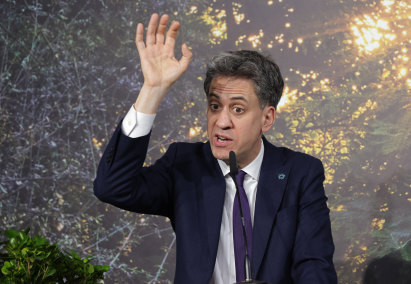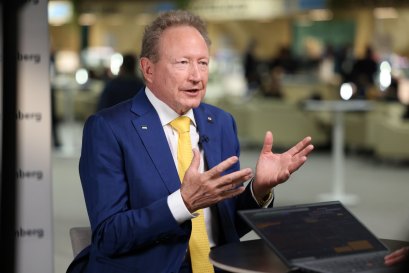
The United Kingdom, Brazil and United Arab Emirates have submitted their NDCs for 2035, including the UK promising to cut emissions by an ambitious 81 per cent from 1990 levels. Britain this year became the first G7 country to phase out coal, switching off its last coal-fired power plant on October 1.
In Baku, UK Energy Secretary Ed Miliband said: “The use of coal is still growing around the world and poses one of the biggest threats to keeping 1.5 degrees within reach.”

Secretary of State for Energy Security and Net Zero of the United Kingdom Ed Miliband unveiled a new 81 per cent emissions reduction target at the talks in Baku.Credit: Getty Images
In 2022, Labor passed legislation enshrining a 43 per cent reductions target by 2030 into law, but the crossbench successfully added amendments requiring the government to take advice from the Climate Change Authority, chaired by former NSW Liberal treasurer Matt Kean, on targets.
An initial assessment by the authority in April showed Australia could reduce its emissions by 65-75 per cent by 2035, based on 2005 emissions, if additional action was taken by governments, industry and households. It is developing advice to government on the 2035 targets.
Albanese last week refused to be drawn on Australia’s 2035 targets, telling reporters “2030 comes before 2035”.
A spokesman for Bowen said: “Our target will be robust and responsible and informed by the experts”.
Speaking from the climate talks in Baku earlier this week, Australian mining boss and climate activist Andrew Forrest challenged both Albanese and Opposition Leader Peter Dutton to announce a 2035 emissions reduction target of at least 75 per cent before the election.

Fortescue executive chairman Andrew Forrest said investors need certainty about Australia’s 2035 targets.Credit: Bloomberg
“I think if either Dutton or Albanese don’t announce a target of at least 75 per cent then investors don’t have certainty,” he said.
“If you want to get big investment into your country, then you get certainty, so I’d say to both of them ‘what about you stop trying to out [play] each other? What about you act in the interest of Australia, and you both announce targets, so investors can know which way the cards are going to fall?’”
The Australian Energy Market Operator’s latest connections scorecard reveals that in September alone, 3.5 gigawatts of wind, solar and battery projects were registered, surpassing the number registered in all of last year, when 2.4 gigawatts was registered.
Loading
At the COP summit this week, the United Kingdom announced a reduction of 81 per cent on 1990 levels and Brazil, host of next year’s COP talks, announced a new commitment to cut emissions by 67 per cent based on 2005 levels by 2035. Brazil’s announcement is seen as particularly significant as it is a top-10 emitter and one of the world’s largest economies.
Brazil’s vice president, Geraldo Alckmin, told the COP29 summit his country’s new target was “ambitious but also feasible”.
Turner said Australia’s states and territories were giving certainty to policymakers and the market.
“Just think how much more we could achieve with a clear national ambition,” she said.
“The UK and Brazil and to some extent, the UAE, have already put forward their emissions reduction targets. That’s an attempt to build a groundswell of targets being put on the table to facilitate negotiations and understanding about where the globe is at. It would be great if Australia was to be a part of that momentum building.”
NSW Climate Change Minister Penny Sharpe said the state was fortunate to have bipartisan support for its climate targets.
“Action to reduce emissions will require efforts at state and federal levels. NSW has its own 2035 target of 70 per cent reduction on emissions and will continue to work towards that.”
Victorian Climate Action Minister Lily D’Ambrosio said the state had “met or exceeded every climate target we’ve set to date”.
“Victoria hit 38 per cent renewable electricity generation this year and is on track to exceed its 40 per cent renewable electricity by 2025 target.”
Get to the heart of what’s happening with climate change and the environment. Sign up for our fortnightly Environment newsletter.



























